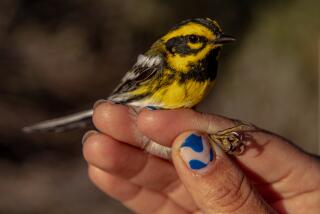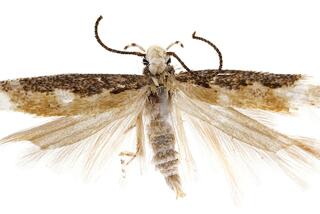Playing the Name Game
Scientists are an amazingly competitive lot. Bestsellers have been written about the race to decipher the structure of DNA, sequence the genome and identify a new solar system.
But another, more amusing race is taking place largely out of the public eye: the scientific effort to find the wittiest names for subatomic particles, species--and especially genes.
Biologists have been the pacesetters in the competition, coming up with such unusual names as Abra cadabra for a clam and Heerz tooya and Heerz lukenatcha for some wasps. But among biologists, the indisputable champions are the somewhat odd researchers who study Drosophila melanogaster, commonly known as the fruit fly.
Drosophilists have so far identified more than 26,000 fruit fly genes--in 46,000 variations--and the majority of them have names that will tickle your funny bone.
Cultural references, science-fiction references, literary references, Latin puns and a host of other in-jokes festoon the official archive of Drosophila gene names, found at www.flynome.com. Despite its esoteric nature, the archive is actually a good evening’s read.
Sophie Rutschmann of the University of Strasbourg, for example, found a mutated gene that causes adult flies to die within two days after they are infected with certain bacteria. She named the gene Kenny, after the “South Park” character who always dies before the end of the program.
Another group found a pair of genes that cause male and female flies to lack external genitalia. The gene names: ken and barbie, after the dolls with the same features. How about a mutant gene that causes some cells to divide uncontrollably? That gene, of course, is named tribbles, after the classic “Star Trek” episode “The Trouble With Tribbles.”
“There is a long tradition in Drosophila research that genes get named in a way that is descriptive and memorable,” says Lawrence Goldstein of UC San Diego. “There are some organisms and systems that you name systematically, but that doesn’t provide a lot of information about what they are doing or the phenotype [appearance] of the animal. They are hard to remember.”
Inventive names make it much more easy to recall what the gene does. Besides, he added, “it’s fun. Scientists aren’t really that boring.”
Goldstein’s lab found a family of gene mutants that cause the movement of materials through the cell to be disrupted. The obvious names were chosen: roadblock, gridlock, sunday driver. “Sunday driver is a particularly antique colloquialism,” Goldstein said. “A Japanese scientist asked me about it once. He couldn’t figure out what it means because the concept doesn’t exist there.”
Goldstein noted that his lab has a blackboard with a list of cute names waiting for the right gene to be discovered.
“There’s also a certain amount of one-upmanship,” he noted. “Dave Susuki [a fly researcher] years ago, wanted to give something a profane name. He went to Japanese to find the name shibere, which means messed up. It is abbreviated ‘shi,’ and it is temperature-sensitive, so it gets the superscript ‘ts.’ ”
If you ask Seymour Benzer of Caltech why Drosophilists use funny names, he replies, “Why not? Science should be fun if you can manage it .... There have always been descriptive names for [fruit fly] mutants going back to the ‘20s, so why not make them humorous at the same time?”
Benzer discovered a mutated fly that was learning-deficient, so he called the responsible gene dunce. When several similar mutant genes turned up, they had a problem finding enough similar names. Because the flies were practically brain-dead, “we decided to name them after vegetables, names like rutabaga, turnip, cabbage and so on.” Others had brain degeneration, and his group named them after foods whose appearance they resembled under a microscope: bubble gum, spongecake, popcorn.
Inventing names “is simply a great tradition,” says Tim Tully of Cold Spring Harbor Laboratory in New York. “If a gene is discovered for the first time, your name takes precedence in all other similar discoveries and homologues in other species. If you are the first one, that is the name forever. It’s romantic and fun.”
Tully’s first scientific achievement was the development of a Pavlovian learning task for flies. The Russian psychologist Ivan Pavlov is famous for having taught dogs to salivate when a bell was rung, a so-called learned response. “Because it is so simplified, this response is a building block for all other more complicated forms of learning,” Tully said. “Rats can learn lots more complicated things than flies, but the elemental change is always caused by the association of two stimuli.”
Tully has so far found 47 gene mutations that affect the learned response in flies. He wanted to name them after Pavlov’s dogs, but there was a problem. In all of Pavlov’s papers, only one dog is mentioned by name: Bierka, which means “whitey.”
Tully went to the Pavlov Institute outside St. Petersburg. Its director was Pavlov’s last graduate student, but he couldn’t recall any of the names. Then Tully “just happened” to go on a private tour of Pavlov’s home, which the curator stated was left as it was the day Pavlov died.
“At the end of the tour, I just happened to ask the curator if she knew about the dogs,” Tully said. “She walked to a cabinet and pulled out a photo album with the pictures and names of all the dogs.” Now Tully’s genes are named jurka, jack, marka, joy and so on.
None of the fly scientists seems able to explain why researchers in other fields don’t follow the same naming practices. A few researchers do, of course. There is a wasp called Verae peculya. There is also Agra sasquatch, a beetle with big feet. There is even Myzocallia kahawaluokalani, an aphid whose name reportedly means, in Hawaiian, “you fish on your side of the lagoon, I’ll fish on the other, and no one will fish in the middle.”
But most researchers shy away from such humor, and the worst offenders seem to be nematologists--biologists who study nematodes--who give each gene a three-letter code, sometimes followed by a number, such as unc-1.
“They don’t quite seem to latch on to the fun,” Tully said.
Drosophilist Jeff Hall of Brandeis University near Boston added: “You can’t dynamite an interesting name out of a nematologist.”






